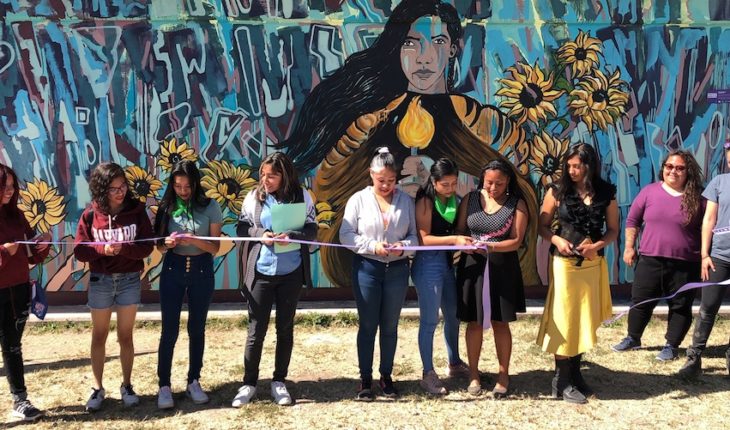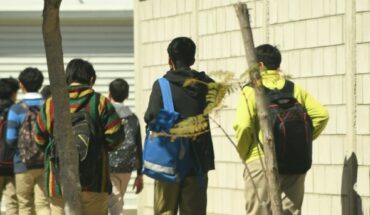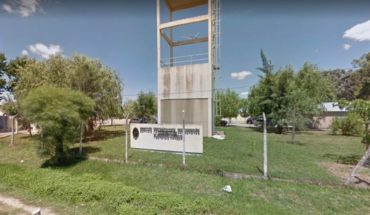It’s Saturday, a waltz rings in the courtyard of the Official High School 128 Francisco Villa, of the State of Mexico. Nine girls in their 15-year-old amp slats give a left step, one right step, one left, one right… before moving to the center of the impromptu track, they scale into a microphone, in which they are presented in the name of others, of the same ages, but who are no longer.
“I am Rosita. I was 17 when in 2016, I was raped and killed. My remains were found on a piece of rubbish in the Hank Gonzalez colony. Yes, here at Hank González, in the municipality of Ecatepec! No one else spoke of me for being a poor woman,” says Mariana in a bright pink dress and a beige sweater.
Read more ‘Girls don’t touch each other, they don’t kill thetwo, they don’t rape theother’: Ecatepec’s young sternes in feminist performance
The makeup on their faces is not a party, but one that simulates blows. They turn like princesses in the watchful and dismayed eye of others and other students and some mothers. In the end, they swap their stuffed dolls for two blankets that express darkness and light:
“Girls don’t touch each other, they don’t rape each other, they don’t kill each other,” reads in the first.
“Broken girls in the hope of being free, ” the second.
This is not a party, but a performance called Quinceañeras. One of several that have created since 2013 the students of the workshop “Women, art and politics”, and who have presented in other schools, even private, of the State of Mexico.
On November 29th, as women from all over the world replicated the Chilean intervention Un Violador on your Way, it caught the attention on social networks that was also made in Ecatepec, the municipality with the most femicides in the whole country, by teenagers wearing school uniform. They were the students of the “Panchito Villa”, as they call their school.
You may be interested: “The rapist is you” the powerful feminist anthem born in Chile that resonates in Mexico, Colombia, France or Spain
But this feminist activism is not new to them or to neighboring colonies. Every 8th of March, Women’s Day, and November 25, Day of Elimination of Violence against Women, are manifested in the vicinity of the school or in San Pedro Xalostoc or Santa Clara Coatitla, the nearby villages.
Teenage girls say that many don’t understand why they do it, light their car, play their horns, or yell at them to start studying. But they are proud of the social activism they are doing and making their voice heard.
High school students also performed “A Violator on Your Way”, and inaugurated a mural painted on the walls of their classrooms.
Being a girl in Ecatepec, Mexico’s most fheminid municipality
Bethlehem, 19, lives almost at the tip of one of the hills of Ecatepec, those that from afar are full of steep houses, which are now painted in bold colors instead of being a huge gray spot that scales over the green. He remembers hearing what was going on above.
“In the wasteland they often threw a lot of girls, that is, they left the bodies lying there, and we found out, because they were in the newspaper,” he says in an interview with Animal Político.
In the last five years, more than a thousand women have been murdered in Ecatepec, although only the legal type of femicide under 60 are investigated.
Just a month ago, a student was grabbed a block from school and put in a car. Fortunately, although amid contempt for her life, she survived, says the director, Leticia Fragoso.
“She told us there was a time when they said ‘she’s no good to us’ and took her out. This little girl is little girl; has short stature, very thin, not developed. And so, ‘it’s no good to us’ and they warn it, as if it were garbage,” she says.
“The parents first were wrong, even very angry with us, that school does. They filed the complaint, I told them to go to the municipality to ask for more security. Then I saw that it was a relief; when I accompany them, in the end Mr. ‘thank you teacher, because no one had listened to us.'”
Pilar, 17, learned in high school that one of her classmates was raped by her uncle.
“Well, it was a very strong thing,” he told a teacher, he had confidence in the teacher. And it was like that he ripped his fingernails off, and he’d come all the way and say, ‘Master, give me alcohol.’ And the teacher once told him what was wrong with him, and then he told him. Then said the teacher, he said to me, ‘help her, support her, for she hurts very ugly.’ He cut off his hands, then he did…” he recalls.
Moving to pre-prep involved new risks. The first week of school, her mother accompanied her to school, but then she was just taking her to the truck stop. Her day-to-day life, she explains, is living on alert, that there may be an assault on public transport, someone to follow her. Try to locate acquaintances or neighbors on the same transfer to stick to them and feel more confident.
“You get out of the way when you walk and they harass you, and you feel, well you feel horrible, you feel dirty, I don’t know… are screams, they are, how could you say? Obscene compliments, that’s not the case. And they still yell at you and chase you,” he says.
She was also afraid of change because her high school counselor, the teacher who was to guide her in her studies, scared her. He crossed his fingers because now in high school he was touched by a female tutor.
But he discovered something and someone he didn’t expect: a teacher, named Manuel Amador, organized a workshop on “Women, Art and Politics”. She knew that they made a kind of plays called performance, to represent the problems of women in her community and decided to integrate.
Chaparrita, with elongated eyes and brunette complexion, of paused speaking, Pilar has become one of the outstanding students of the workshop. He goes in the third semester, but he speaks with the clarity and maturity of someone much older. In addition to the performance of Quinceañeras, they have performed another inspired by the so-called “Monster of Ecatepec”, which committed more than 10 femicides. They made cement skirts that represented the immobility to which he subjected women, including his partner, who assisted him in his crimes.
The students explain that Prof. Amador has taught them that women can excel, that they are to be cared for and not to humiliate themselves. They have learned what a femicide is and that it not only harms them as women, but the whole community. They know what misogyny, machismo, is, and that even if they see it at every turn, it’s not something they should allow.
In addition, they have also found in the teacher someone who supports them in their problems and gives them advice, like a girl who comes with tears because they have just made her feel bad because she likes other girls. “They have to accept you as you are,” is the message to her and to every young woman in the midst of this difficult context.
The day the UN even turned to see the “Panchito Villa”
The most recent activity of the teenage girls of the Panchito Villa Prepa has been to paint a mural sponsored by nothing more and nothing less than the UN and the European Union.
The school has the ground floor, except in some hallways and on the basketball court. Above one of the hall buildings in the background, the iron castles stand out to one day build a second floor.
It was founded in 1994 by the José María Morelos y Pavón People’s Union as a community effort to create the first upper middle-level school in the area, and it was almost 10 years before the government turned it into an Official Preparatory School (EPO), in 2003.
His ideology is to give education to create new, more egalitarian social relationships. In 2013, several teachers who were concerned with giving a little more to the students created various extracurricular workshops: poetry, sports, photography, and that of women, art and politics, of profe Amador. None of them get paid extra for doing so, nor do young people earn points. Everything is voluntary.
So this activism and artistic activities have been building a reputation for the school. That’s why, when the UN Spotlight initiative, dedicated to focusing efforts against femicide in five municipalities in Mexico, sought an intervention in Ecatepec, the name of Francisco Villa High School immediately emerged.
The most recent activity of the teenage girls of the Panchito Villa Prepa has been to paint a mural sponsored by nothing more and nothing less than the UN and the European Union.
In alliance with the Tomato Collective and the Initiative México Well Hecho, of Comex, which makes murals in areas of high criminal incidence, they approached the school to propose to capture the fight against sexist violence on the walls of their halls.
The selected artist was Liz Rashell. Two weeks earlier, he arrived with a new express workshop: he taught young people how to sketch and some painting techniques for anyone who wanted to help in the mural. He also accompanied them in his art and policy workshop, to see their performances, meet them and listen to their concerns.
Some of the drawings made by the students were obscure, with a woman injured, or made ball covering his face. But others reflected a lot of hope, with pigeons flying.
“Analyzing all the sketches they made, everyone talks about freedom, everyone talks about courage. So it is not necessary to put the image of their reality, but rather to inspire them to take action, it was what I shared with them, that they can transform their situation. Don’t make them feel like this is going to be their reality all the time. So it was strong, but at the same time very inspiring,” Rashell explained.
So it was finally decided that one half of the mural would be a fist, as a symbol of the harsh reality they live in, and the other, a woman who looks head-on and holds a torch, like hope. Both images surrounded by sunflowers, because flowers are always a constant in the artistic representations that girls make.
For a week lan artist painted, helped mainly by Pilar, Karen, Fernanda, Joana, Sebastian and others, the girls and the only boy in the workshop of profe Amador.
This Saturday, on a day with performance and speeches by the students on gender equality, respect for women and the damage of a misunderstood masculinity, before television cameras and with the presence of representatives of the UN, finally opened the mural “Woman Warrior”, with a plaque that will always remind them of the message:
“We are strong because we respect each other. We’re strong because we love each other. Strength, decision and leadership characterize the students of the Official Preparatory School 128 General Francisco Villa”.
What we do in Animal Político requires professional journalists, teamwork, dialogue with readers and something very important: independence. You can help us keep going. Be part of the team.
Subscribe to Animal Politician, receive benefits and support free journalism.#YoSoyAnimal
translated from Spanish: Ecatepec students who make anti-violence interventions
December 13, 2019 |





